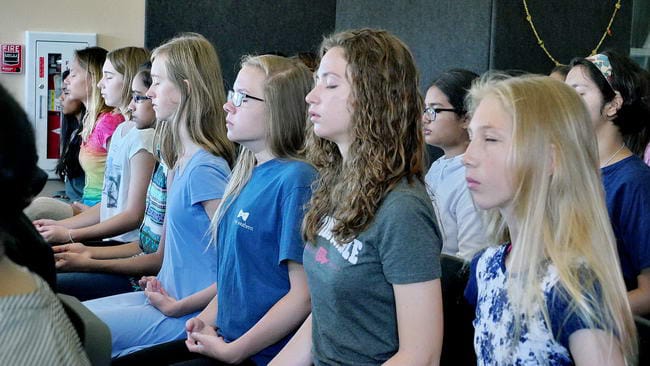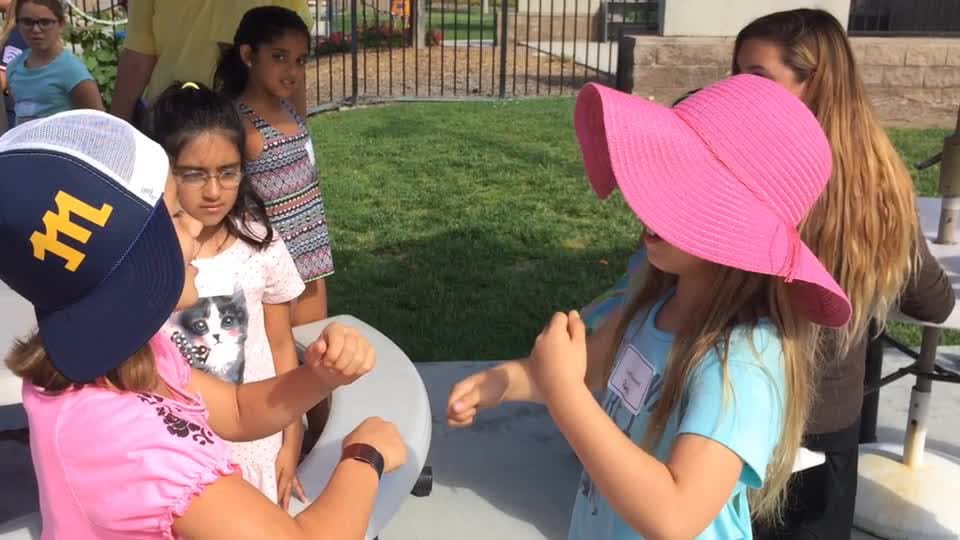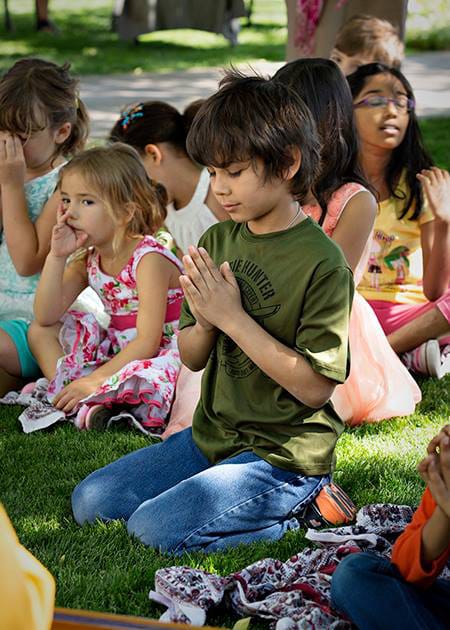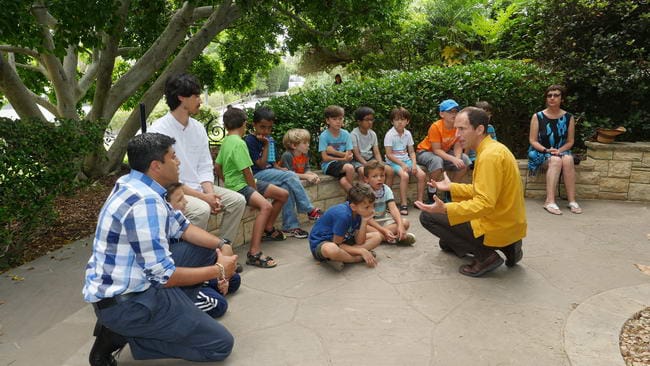"Helping Children Live a God-Centered Life" by Jonathan Wolff (SRF YSS magazine)
This out-of-print interview of Jonathan Wolff was published in Yogoda Satsanga magazine in 1995 (Oct-Dec).
Helping Children Live a God-Centered Life - Jonathan Wolff
Advice for YSS/SRF parents, with examples from SRF “How-to-Live” Summer Youth programs: An interview with Jonathan Wolff
As a teacher, school administrator, and education consultant, longtime Self-Realization Fellowship member Jonathan Wolff works with parents and teachers in public and private schools throughout the United States.

Q: Raising happy, well-adjusted children—a challenge at any time in history—has proven in the last decade to be fraught with greater obstacles than ever before. Drug abuse, promiscuity, and violence have reached epidemic proportions. Do you have any suggestions to help parents negotiate the mine fields of modern society?
JW: I believe Paramahansa Yoganandaji’s statement, “Change yourself and you will change thousands,” is perhaps the most important principle parents can follow. The young lives entrusted to us respond more Positively to the good examples we set than to all our well-meaning lectures and daily exhortations on discipline. We do not have to be perfect in order to be good parents; we only have to strive sincerely without being didactic or self-righteous, to love God and live the path to the best of our ability.
…offer children a positive alternative to the undesirable influence—to expose them, for example, to a dramatic piece of classical music rather than forbid them to listen to their favorite rock group.
The Master also said, “Environment is stronger than will power.” Physical surroundings and peer relationships influence children’s attitudes and behavior, but their “environment” also includes the TV shows and movies they watch, the music they listen to, the toys they play with, the books they read, and so on. I once had a four-year-old student who began regularly to warn his classmates about a “debil” who could reach up from inside the earth and pull bad children underground. After several heated warnings, one of his playmates turned to the boy and said, “You know, I think you’ve been watching too many cartoons.” Sometimes, when an experience promotes values that are not in a child’s best interests, it is imperative for parents to say “no,” even to something the child dearly desires. Other times the best strategy is to offer children a positive alternative to the undesirable influence—to expose them, for example, to a dramatic piece of classical music rather than forbid them to listen to their favorite rock group. Sowing the seeds of beneficial experiences is much more effective in the long run than trying to uproot the weeds of old habits. This is exactly what Paramahansaji counsels in Scientific Healing Affirmations when he tells us to focus our attention on the positive quality we want to develop rather than on the negative habit we want to overcome. Too often, parents spend more time and energy nagging their child about misbehavior than they do modeling the attitudes and actions they want the child to develop. “Please walk” is far more effective than “Don’t run.” “Here’s how I hold my fork when I eat my peas” is much better than “Stop eating like a pig!” Role-playing how to greet a guest with a warm smile, eye contact, and a cheery “hello” will accomaplish a lot more than “Get over here and say ‘hello’ to Mrs. Jones!”
It’s also important to help children learn to evaluate their thoughts and actions. This teaches them two invaluable lessons: the law of karma, and that they can choose how they will respond to circumstances.

Many years ago, I had a class of preschoolers in which a number of the children reacted to the typical challenges of that age group by whining. “Mr. Wolff, I can’t button my jacket.” “Mr. Wolff, I can’t open any lunchbox!” I (quickly!) gathered the class together, saying I had some questions I wanted to ask them. I began the discussion by playing the role of a young boy who discovered his shoe was untied. He was feeling quite helpless and victimized, and responded to the situation by whining. After my theatrics, I asked the children two questions: how was the boy feeling, and did his behavior solve his problem?
When the children finished sharing their thoughts, I role-played the scenario three more times to show the effect of various responses to problems. In the second demonstration, I denied I had a problem. “No worries,” I said, “I’ll be inside today.” Then I pretended to trip over my shoelace! (Ignoring a problem does not make it go away.) In the third scenario I reached out for help by asking an older child to tie any shoe; in the fourth I pretended to ask my teacher to show me how I could tie my shoe myself. After each demonstration I asked the children how the “boy” was feeling, and did he get what he wanted. With very few words on my part, they quickly learned “strategies” for improving the quality of their lives and feeling better about themselves in the process.
…guided questioning is a very effective way to stimulate a child’s critical thinking and problem-solving abilities.
This type of “guided questioning is a very effective way to stimulate a child’s critical thinking and problem-solving abilities. It’s not always necessary to do role-plays with this technique. The idea is to choose a scenario that relates to something going on in the child’s life, and ask structured questions that help him discover the best solution to the problem on his own. If a young child throws his toys, you might ask, “If I were to throw this block across the room, what do you think might happen?” After he responds, present an alternative, such as, “If I took this block and set it on the shelf like this (demonstrate the appropriate behavior), what do you think might happen?” Finally, have him tell you how he plans to care for the block. With older children, you might ask how they think Master or some other worthy person they idealize would want them to solve the problem.
Within the boundaries of emotional security and physical safety, allow children to make mistakes. Sheltering them from the world and the effects of their own errors in judgment is a sure way to create fearful, failure-oriented adults. Teaching them that mistakes are opportunities to learn instills in them the courage and confidence necessary to be a success at anything they do.
Q: How can parents interest their children in meditation?
The most important message children receive about meditation is the one we communicate through our own regularity and devotion.
JW: Once again, I think the most important message children receive about meditation is the one we communicate through our own regularity and devotion. Men tend to relate to meditation as a self-disciplinary challenge—the victorious battle with mind and body—while women tend to emphasize the more devotional aspects. As a result, parents generally emphasize one or the other with their children, particularly with the child who is the same gender as the parent. Boys and girls need to understand that the practice of meditation requires both self-control and self-surrender, that both qualities are necessary to go all the way to God.

Younger children, especially two- to eight-year-olds, respond favorably to being invited to participate in their parents’ meditations. The ground rule is: “You may stay as long as you like, but please sit and leave quietly so the others will not be disturbed.”
An atmosphere of reverence is very attractive to a young child. Dim the lights, light candles and incense, put on devotional music, lower your voice to a whisper at meditation time. Move away from the verbal and into the realm of the heart. This engages the child in the wonder of meditation. If he begins to take the routine for granted, create a variation, perhaps by changing the music. The point is to give children experiences that stimulate their inherent spirituality.
Pushing them beyond what they are developmentally or emotionally capable of is a sure way to turn them off to meditation. As a general guideline, the SRF Sunday Schools and Youth Program recommend less than five minutes of meditation (including chanting) for children 3 to 6 year old, ten minutes maximum for 7- to 8-year-olds, fifteen minutes for 9- to 10- year-Olds) fifteen to thirty minutes for 11- and 12-year-olds, and thirty to forty-five minutes for 13- to 15-year-olds.
Simple observation will tell parents when their children have reached—or can stretch—their limits. Parents need to beware of becoming too emotionally invested in having their children be perfect YSS/SRF yogis. Our job as parents is just to plant the seeds, not water or prune the saplings to death!
Q: What Is the best way to communicate the “how-to-live” aspects of Paramahansaji’s teachings to children?

JW: Talk about the teachings in the context of the child’s life. One year at the Youth Program the rivalry over a volleyball game between two groups of older boys got out of hand. What began as friendly teasing soon escalated into harassment and disrespect. One of the group leaders brought both groups together, reviewed what was happening, and then simply asked the boys how Master acted with people who were opposed to his views. From that moment on, everything changed and the boys worked and played together harmoniously. The group leader started with where the boys were at and related their problem back to Master’s teachings.
There are six criteria parents should keep in mind when communicating the Master’s teachings to their children:
- What is the child’s basic temperament? Is he primarily motivated by intellect, will, feeling, or a combination thereof? A child who is more intellectual responds best to logic and reason; one who is more emotional responds to a devotional call; one who is primarily will-oriented responds best to action-oriented subjects.
- What is the child’s primary learning style? Is he visual (use pictures of the Gurus), auditory (try chanting), tactile (communicate through crafts), or kinesthetic (use energization exercises and role-playing)?
- What are the childs’s natural interests? if a boy loves fighter planes, relate the concepts of life force, will, and concentration to flying an F-16 in intricate maneuvers.
- What are the child’s natural abilities? Is he artistic athletic, or musically inclined?
- What is the child’s current challenge? Is he battling peer pressure, personal acceptance, fear of the dark? Many of the stories in Autobiography of a Yogi, “Mejda,” and the Yogoda Satsanga Society Lessons are well suited to address these and other issues.
- What are the child’s aspirations or desires? If he wants to be a dancer or a soccer player, show him how practicing the teachings can help him attain his goal.
Q: How important is it for a child in a YSS/SRF family to learn about other religions?

JW: Children need to understand that all true religious paths lead to God, and that anyone who is making a sincere effort to know and love God deserves their respect. Loyalty to the Yogoda Satsanga / Self-Realization teachings does not preclude knowledge of and respect for other religions. When talking about the benefits of our Guru’s teachings to your child, remember to use “I” messages: “I” chose YSS/SRF because Master gives specific techniques that can help me experience God’s love and Joy.” A pronouncement such as “Yogoda Satsanga Society/Self Realization Fellowship is superior to other religions because of the meditation techniques”, is loaded with religious dogmatism and prejudice.
Q: What you’re saying to parents is that they really need to “walk their talk.”
…the greatest positive impact on our children comes as a result of doing more “walking” than “talking”
JW: Absolutely! In fact, the greatest positive impact on our children comes as a result of doing more “walking” than “talking”! A child who consistently sees his parents express peace, cheerfulness, perseverance, and kindness is much more likely to be drawn to form a personal relationship with God and to follow a spiritual way of life.